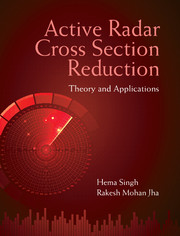Book contents
- Frontmatter
- Dedication
- Contents
- List of Tables
- List of Figures
- List of Abbreviations
- Preface
- Acknowledgements
- 1 Introduction to Radar Cross Section Reduction
- 2 RAM Analysis for Low-Observable Platforms
- 3 Radar Cross Section of Phased Antenna Arrays
- 4 Active RCS Reduction in Phased Arrays
- 5 Mutual Coupling Effects in Phased Arrays
- 6 RCS of Dipole Array Including Mutual Coupling Effects
- 7 Performance of Sidelobe Cancellers in Active RCSR
- 8 Emerging RCSR Techniques
- Epilogue
- Appendices
- List of Symbols
- Suggestions for Further Reading
- Author Index
- Subject Index
6 - RCS of Dipole Array Including Mutual Coupling Effects
Published online by Cambridge University Press: 05 April 2015
- Frontmatter
- Dedication
- Contents
- List of Tables
- List of Figures
- List of Abbreviations
- Preface
- Acknowledgements
- 1 Introduction to Radar Cross Section Reduction
- 2 RAM Analysis for Low-Observable Platforms
- 3 Radar Cross Section of Phased Antenna Arrays
- 4 Active RCS Reduction in Phased Arrays
- 5 Mutual Coupling Effects in Phased Arrays
- 6 RCS of Dipole Array Including Mutual Coupling Effects
- 7 Performance of Sidelobe Cancellers in Active RCSR
- 8 Emerging RCSR Techniques
- Epilogue
- Appendices
- List of Symbols
- Suggestions for Further Reading
- Author Index
- Subject Index
Summary
Introduction
Radar cross section (RCS) of an aerospace vehicle significantly depends on the scattering of the on-board mounted antenna array. This antenna mode scattering is dependent on (i) the geometry of the phased array, (ii) the nature of the feed network employed to excite it, and (iii) the Mutual Coupling effect. A phased array, in general, requires a feed network to function as an effective transmitter or receiver. This feed network comprises radiating elements, phase-shifters, couplers and terminating resistors. Depending on their mode of arrangement, the feed network may be categorised as series feed, corporate-feed and space-feed (Volakis 2007).
To design a complete phased array system with specific radiation characteristics, several factors like the number of elements, their inter-element spacing, beam scan angle, arrangement of phase shifters, couplers, and loads have to be considered. Further, if the spacing between the antenna elements is less than half-wavelength, the effects of mutual coupling become predominant. These parameters of the array design are found to affect the RCS of the array considerably.
Mutual coupling affects the impedance of the array elements, reflection coefficients, radiation pattern and, thus, the RCS of phased array. Every element in the antenna array is of a definite physical size and shape. The incident wave on each of these elements will reradiate due to various reasons, such as the mismatches in the network, manufacturing defects, etc. The fields radiated from one antenna element interact with those of the surrounding antennas, giving rise to mutual coupling. These reradiated fields when scattered along different directions affect the RCS of the target significantly.
Further, the effect of mutual coupling on the array performance is influenced by (i) the feed network, (ii) array scan angle, and (iii) the geometry of the antenna array, viz. side-by-side, collinear and parallel-in-echelon configuration. The literature available in the open domain presents several methods to estimate the antenna RCS.
- Type
- Chapter
- Information
- Active Radar Cross Section ReductionTheory and Applications, pp. 216 - 244Publisher: Cambridge University PressPrint publication year: 2015



